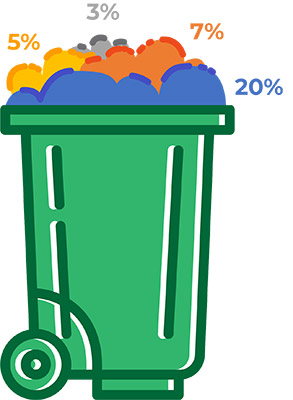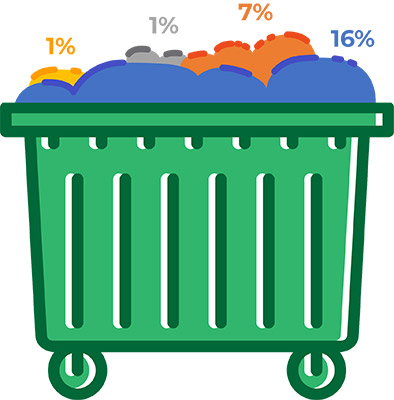Approximately 30% of all waste landfilled in the province is from a category called organics. This waste is primarily composed of:
- food waste
- soiled paper products (like paper towel and cardboard packaging)
- yard and pet waste.
Organic waste comes from both the residential and Industrial, Commercial and Institutional (ICI) sectors. When we landfill organics, it produces greenhouse gases (GHG’s). Reducing your organic waste is one thing many can do to reduce GHG emissions and help protect the environment.
Residential sector
About 1/3 of what we throw away at home is organic. A breakdown of the types of organic waste from this sector is presented below.

Figure 1: Approximate breakdown of organic waste from the residential sector.
5% – Pet waste
3% – Leaf and yard waste
7% – Soiled paper
20% – Food waste
Industrial, commercial, and institutional sector
About 1/4 of what the Industrial, Commercial and Institutional sector (i.e., Businesses, factories, schools) throw away is organic. A breakdown of types of organic waste from this sector is presented below.

Figure 2: Approximate breakdown of organic waste from the Industrial, Commercial and Institutional sector:
1% – Pet waste
1% – Leaf and yard waste
7% – Soiled paper
16% – Food waste
- Practice meal planning: Make weekly menus and purchase only what you can consume before it expires.
- First in, first out: Use older items first to help avoid spoilage.
- Keep it fresh: Keep fruits, vegetables, meats, and dairy in appropriate refrigerator drawers to extend their life.
- Store foods in see through containers
- Use top shelves for prepared foods and leftovers and bottom shelves where it's cooler for meat, dairy and other raw ingredients.
- High humidity crisper drawer is for 'thin-skinned' produce like leafy greens, cucumbers, carrots, broccoli, and strawberries
- Low humidity crisper drawer should be used for fruits and veggies that produce ethylene gas, like apples, pears, peaches, melons, mangos, and avocados. Leaving the vent open gives the gas a chance to escape.
- Please freeze: Be mindful of expiry dates and remember to freeze extra meat, dairy products, and tofu.
- Use leftovers: Incorporate leftovers into future meals like soups, stir fry’s, smoothies, and stocks.
- Share: Extra food with family, friends or donate to community organizations like food banks.
- Compost: Participate in a curbside organics program or try composting at home.
- Replace it: Use reusable cloths instead of paper towels or napkins.
- Mulch it: Avoid raking your lawn clippings and leaves. Instead, mulch into lawn as it provides nutrients and reduces the need for fertilizer.
- Integrate it: Till plants back into garden soil to provide nutrients and water holding capacity for next year.
Composting is the most common method of diverting organics from being landfilled and it produces a nutrient rich material for gardens and landscaping projects. Curbside organics programs are currently available within the Fundy, Kings, Kent and Southeast Regional Service Commissions. For those living outside these regions, community or composting at home may be an option.
Additional information may be found in the composting handbook or from your local regional service commission.
Acceptable materials within Regional Service Commissions that provide a curbside organics program may differ and accept more items than those recommended when composting at home. Visit your local Regional Service Commission webpage for more information.
There are several ways to compost at home. Some Indoor methods may limit the types of organics you can compost while recommended compostable items using backyard methods generally include those listed below. For more information on composting at home, visit the resources provided on this page.
- Fruits and vegetables
- Crushed eggshells
- Coffee grounds and filters
- Tea bags
- Nut shells
- Shredded paper
- Yard and garden clippings
- Houseplants
- Hay/straw/leaves
- Sawdust and wood chips
- Hair and fur
- Fireplace ashes
- Coal or charcoal ash
- May contain substances harmful to plants.
- Dairy products and eggs
- Create odour problems and attract pests.
- Fats, grease, lard, or oils
- Create odour problems and attract pests.
- Meat or fish bones and scraps
- Create odour problems and attract pests.
- Pet wastes (e.g., feces, cat litter)
- May contain parasites or pathogens, harmful to humans.
- Yard trimmings treated with pesticides
- May kill beneficial composting organisms
Composting is the most common method of diverting organics from being landfilled and it produces a nutrient rich material for gardens and landscaping projects. Curbside organics programs are currently available within the Fundy, Kings, Kent and Southeast Regional Service Commissions. For those living outside these regions, community or composting at home may be an option.
Additional information may be found in the composting handbook or from your local regional service commission.